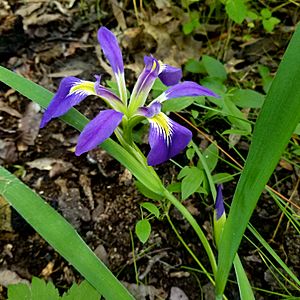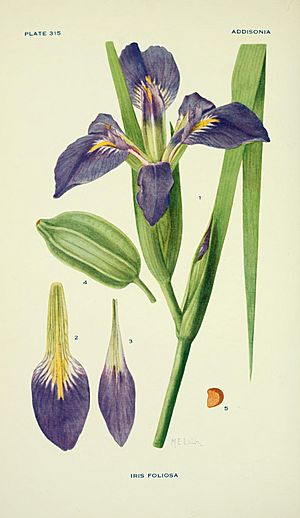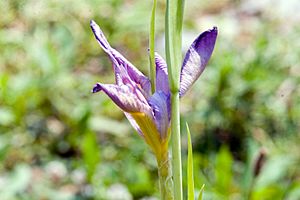Iris brevicaulis facts for kids
Quick facts for kids Iris brevicaulis |
|
|---|---|
 |
|
| Conservation status | |
| Scientific classification | |
| Genus: |
Iris
|
| Species: |
brevicaulis
|
| Synonyms | |
|
|
The Iris brevicaulis is a type of iris flower. It's part of a group called Hexagonae, which are known as Louisiana irises. This plant is a perennial, meaning it lives for more than two years. It grows from a special underground stem called a rhizome.
This iris is found in North America. It has bright green, shiny leaves and a unique zig-zag stem. Each stem can have 3 to 6 flowers. These flowers come in many beautiful blue shades, from violet-blue to light blue.
Contents
What Does Iris brevicaulis Look Like?
The Iris brevicaulis is the smallest of all the Louisiana irises. Its leaves and stems are much shorter than other types. It looks a bit like the Iris virginica plant.
Its flowers are often hidden by the leaves. This is because its zig-zag stems are short. Sometimes, the stems even lie along the ground.
Roots and Stems
This iris has rhizomes that grow close to the surface. These rhizomes are like thick, branching roots. They can spread out and form large groups of plants, sometimes up to 2 by 3 feet wide.
The plant has long, shiny leaves that look like swords. They grow from the base of the plant. These leaves are bright green and can be about 40 to 70 centimeters (16 to 28 inches) long. They are also about 15 to 40 millimeters (0.6 to 1.6 inches) wide.
The stem of the Iris brevicaulis is very special. It grows in a zig-zag pattern, almost like a lightning bolt. This is why it's often called the "Zig-zag iris." The stem grows about 12 to 20 inches (30 to 50 centimeters) tall. Each stem usually has 3 to 6 flowers. There are 1 or 2 flowers at each bend of the zig-zag stem, and some at the very top.
Flowers and Seeds
Iris brevicaulis starts to bloom in late spring to mid-summer, usually from April to July. Sometimes, it doesn't produce flowers every year.
The flowers are mostly blue, ranging from deep violet-blue to light blue. You might even find a rare white flower! These large flowers are about 3.5 to 5 inches (9 to 13 centimeters) wide. They have petals that stand upright and sepals (outer parts) that arch downwards.
The petals have dark veins and are smaller than the sepals. The sepals have a yellow or whitish-yellow patch in the middle. This patch often has a fuzzy, yellow "beard" on it.
After the flowers, the plant grows a seed capsule. It's shaped like a 6-sided box, similar to the Iris hexagona. This capsule is about 3 to 5 centimeters (1.2 to 2 inches) long. Inside, the seeds are round and have a cork-like coating. This coating helps them float in water, which spreads them to new places in wet areas.
Plant Genetics
Most irises are diploid, meaning they have two sets of chromosomes. This helps scientists identify different types of irises and their hybrids. The Iris brevicaulis has 44 chromosomes.
Naming the Iris brevicaulis
The name Iris brevicaulis is pronounced EYE-riss brev-ih-KAWL-iss.
It has a few common names. People often call it the 'Zig-zag iris' because of its stem. It's also known as the 'short-stemmed iris' or 'Lamance iris', especially in Tennessee. In Ohio, it's sometimes called 'Leafy Blue Flag'.
The name 'Lamance iris' comes from Lora La Mance, an American gardener and writer. The word 'Brevicaulis' comes from Latin and means 'short stem'.
This iris was first officially described in 1817 by Constantine Samuel Rafinesque. He wrote about it in his book 'Florula Ludoviciana', which means 'Flora of the State of Louisiana'.
For a while, another name, Iris foliosa, was used for this plant. But later, scientists like Brian Mathew and Clive Innes agreed that Iris foliosa was actually the same plant as Iris brevicaulis. So, Iris brevicaulis is the correct and accepted name.
The United States Department of Agriculture and the RHS have both confirmed Iris brevicaulis as an accepted plant name.
Where Iris brevicaulis Grows
The Iris brevicaulis is known for being the toughest and most adaptable of all the Louisiana irises. It can grow in many different places. It is a native plant to North America.
Geographic Range
You can find Iris brevicaulis in Ontario, Canada, as far north as the shore of Lake Erie. In the United States, it grows in many southeastern states. These include Alabama, Arkansas, Florida, Georgia, Illinois, Indiana, Kansas, Kentucky, Louisiana, Mississippi, Missouri, Ohio, Oklahoma, Tennessee, and Texas.
Natural Home (Habitat)
Most Louisiana irises prefer very wet areas, like the bayous of southern Louisiana. However, Iris brevicaulis can handle drier soils better than other types. This means you can find it away from swamps too.
It grows in moist fields, wet meadows, and damp woodlands. You might also see it along streams, riverbanks, and around lakes and ponds. It likes places where there's a lot of moisture during the fall, winter, and spring.
Protecting Iris brevicaulis
Because its natural homes are sometimes destroyed, Iris brevicaulis is considered 'endangered' in some areas. In Canada, it's only found in Ontario. The Committee on the Status of Endangered Wildlife in Canada (COSEWIC) has marked it as a high-priority plant to protect. A large group of these irises on Pelee Island is now being saved by volunteers.
In the US, it was listed as 'threatened' in Ohio in 2012. In Illinois, it's not very common and is found in scattered places.
How to Grow Iris brevicaulis
Louisiana irises generally need similar care. Iris brevicaulis likes acidic soil (with a pH level of about 6.5). The soil should also have lots of organic material and be rich in nutrients. It grows best in full sun but can also handle some shade. While it prefers wet soil, it can also grow in soil that drains well.
Care Tips
For the best flowers, the plant needs plenty of moisture from late autumn through spring (October to May). This is when the plant grows new leaves. You can give it a light feed (fertilizer) between autumn and spring if it needs it.
You can plant these irises by the edges of ponds, streams, or pools. They also do well in a bog garden or a woodland border. Once they are settled, they are good for cutting flowers. Deer usually don't bother them much.
Reproduction and Growth
The easiest way to grow more Iris brevicaulis is by dividing its rhizomes. This is best done in late summer to early spring when the plants are not actively growing. Before planting, prepare the soil by adding a good amount of organic material. Dig the soil about six inches deep to give new roots space to grow. To keep the plant flowering well, you should divide it every 3 to 4 years.
If you use fertilizer, sprinkle it around the plant in late January or February, before it flowers. New plants need to be covered with mulch to protect them from too much sun.
Growing irises from seed can be slow. It can take many months for the seeds to sprout, sometimes 3 to 12 months. About half of the seeds usually sprout. It's best to start them in a cold frame. Then, it can take 3 to 5 years before these new plants produce flowers.
You should collect seeds from the plant right after it flowers, but make sure the seed pods are mature. Store them in paper bags, as seeds stored in glass containers can get moldy.
This iris is very tough. It can grow in USDA Hardiness Zones 4 to 9. This means it can handle cold winters and is considered the hardiest of all Louisiana Irises.
It can survive frost, but it might not flower well in places with cool summers. You can grow it in the southern UK, most of the United States, Canada, New Zealand, and Australia.
These plants are generally easy to care for and can even handle deer nibbling on them. You can often find them at water garden centers in the US.
Is Iris brevicaulis Poisonous?
Like many other irises, most parts of the Iris brevicaulis plant are poisonous. This includes the rhizome (underground stem) and the leaves. If someone accidentally eats them, it can cause stomach pains and vomiting.
Touching the plant can also cause skin irritation or an allergic reaction for some people. The roots, seeds, and plant sap can all irritate the skin if touched.
How Iris brevicaulis is Pollinated
Iris brevicaulis is mostly pollinated by bumblebees. But sometimes, hummingbirds also help pollinate these flowers.
Hummingbirds pollinate the iris in a unique way. They push their heads into the flower to reach the nectar. As they do this, pollen sticks to their forehead, and they carry it to the next flower.
Hybrid Iris brevicaulis Plants
Because Iris brevicaulis is so tough and can grow in many different places, plant breeders often use it to create new types of irises. These new types are called hybrids.
Iris brevicaulis can easily mix with other Louisiana irises to make new varieties. One of the first hybrids was 'Iris fulvala'. This was created by crossing Iris fulva with Iris brevicaulis. It produced flowers with rich, velvety petals, some red-purple and some bluer. These hybrids were good garden plants and flowered more often than their parent plants.
It was also crossed with Iris giganticaerulea to create a hybrid called 'Iris × flexicaulis'. Another very old hybrid, almost 100 years old, is 'Dorothea K. Williamson', which also has Iris brevicaulis as a parent.
Here are some other types of Iris brevicaulis that have been developed:
- 'Alabamensis'
- 'All Falls'
- 'Boonensis'
- 'Brevipes'
- 'Finders Keepers'
- 'Foliosa Alba'
- 'Mac's White'
- 'Meadow Frost'
- 'Mississippiensis'
- 'Ottine'
- 'Petite And Sweet'
- 'Pink Joy Roberts'
- 'Slowpoke'
- 'Territorial Rights'
- 'Trail Of Tears'
- 'Triple Treat'




